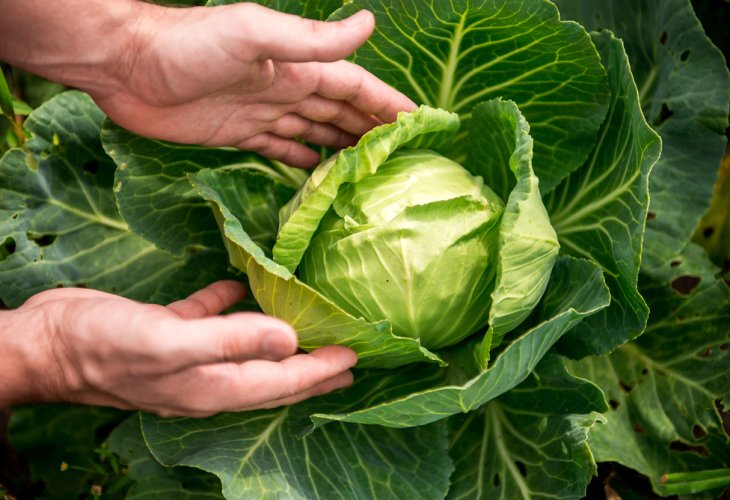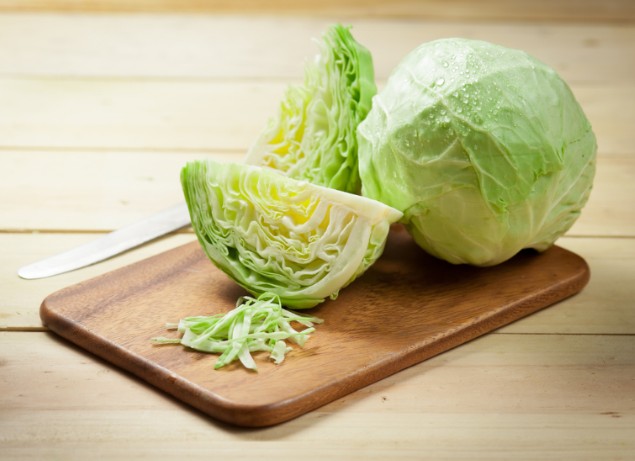Conquering the (Cabbage) Head
There's likely a reason cabbage earned the image of a rotten cabbage head: many creatures lurk beneath its perfect outer leaves. Protect your head
 (Photo: shutterstock)
(Photo: shutterstock)Today, cabbage heads are sold wrapped in bags adorned with various stamps certifying that there are no insects or anonymous caterpillars inside. Sometimes the high price causes customers to glance suspiciously at the cabbage sitting not far away on the shelf, representing the world of the past, when cabbage was still grown and priced normally. The recent price increase has also been a time for reflection, and to remember why we all pay the price.
Indeed, the truth must be told, cabbage is a food loved not only by humans but also by entire diverse families of caterpillars and insects, particularly thrips that visit it from the beginning of its growth when it is still a flower with open leaves close to the ground. The combination of the vegetable's nature and its proximity to the soil creates a breeding ground for extensive infestations, especially as its leaves curl and close, becoming a trap for all the caterpillars walking on it without the ability to escape. Additionally, there are infestations of small flies and aphids that lay their eggs on its outer leaves.
To grow vegetables that are not considered infested, a special growing method was developed using special soil substrate inside closed greenhouses made of very dense netting that prevents insects and flying pests from entering from outside, with massive spraying also coming from the irrigation system to prevent the development of insects from inside. However, this growing method is not suitable for commercial marketing since its cost is estimated at hundreds of thousands of shekels, and growing with this method takes longer than usual and is mainly suitable for the cold winter months compared to the hot summer months when greenhouses are scorching and the vegetables inside rot or dry out.
Cabbage from regular cultivation is considered one of the most infested leafy vegetables, and it is forbidden to eat it unless it has been cleaned and checked by a knowledgeable person above the age of bar/bat mitzvah who is very familiar with the cleaning and inspection process and does it carefully. By the way - even cabbage "from special cultivation without insects" is not 100% sure to be free of insects and aphids, especially during packaging, and requires washing under a strong stream of water.
 (Photo: shutterstock)
(Photo: shutterstock)A common mistake many people make is thinking that pickled cabbage in preserves, and cabbage marketed as chopped, washed, and packaged, is from special cultivation. We regret to inform you that the situation is much worse than that, and even when it has "mehadrin kosher certification," the cabbage is from regular cultivation in open fields. After repeated tests, it was clarified that to bring it to a finished product clean of insects, there are three parameters: a. That the cabbage is grown in an isolated manner with strict supervision of spraying, and the measure for this is if after peeling seven of its outer leaves, the inner cabbage leaves are presumed clean. b. All cabbage leaves should be opened and undergo two thorough washings in new generation cleaning machines (jacuzzi) that will ensure complete cleaning. c. Examination of the vegetable leaves and washing water to ensure the vegetable is clean.
In Israel, there are a very limited number of factories that produce pickled cabbage with kosher certification, and for most of them, not only is the cabbage supplied to them below all standards. Especially this year when winter was late in coming and the warm days provided a fertile ground for those caterpillars, and what's more, the washing machines in those places are outdated and inefficient. However, there are factories where there is special production under Badatz kosher certification that produce pickled cabbage or cabbage in mayonnaise, and the cabbage marketed to them is relatively clean, and often the cabbage is imported from Holland because it is a relatively cold country and the crops there are considered cleaner than the crops here. Additionally, they have the most efficient machines currently on the market. Indeed, these days they are working on developing a highly efficient cleaning machine for pickled cabbage, and time will tell...
By the way- one should follow how the fate of - parsley, cilantro, oregano, and other dried and ground leafy herbs marketed as spices will be decided. These days a stormy halachic controversy is taking place after findings of insects or caterpillars were found in every sample tested. These vegetables are from regular cultivation and do not undergo proper washing, and they rely on drying them in an oven and washing them, but oven drying is not enough to completely destroy the worms, and sometimes they remain whole because the grinding of the leaves is coarse (more than 1-2 mm) and are considered in halachic terms as "briya" (a whole creature) which prohibits the entire mixture in which it is placed. Those who permit them rely on combining several halachic doubts to permit them.
Recommendation - The only way to permit the use of pickled cabbage today - shake the box well before opening it, open a narrow opening to remove all the water and filter through a flour sieve. Then remove the leaves and soak in soapy water for about 3 minutes and wash them thoroughly while rubbing under a strong stream of water. It is important to emphasize that one should give the leaves several shakes to drop the caterpillars from them, after washing, the filtered pickling water can be returned to the cabbage so that after a few hours it will return to its previous taste.

